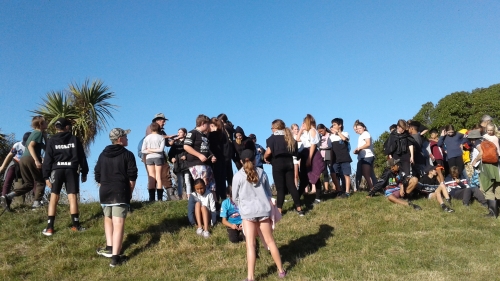

Take one perfect Hawke’s Bay autumn day, fifty enthusiastic Year 7 and 8 students, two teachers brave enough to take learning outdoors and a passionately supportive community of helpers and what do you get? Unforgettably relevant, place-based learning!
On May 23rd 2019, two classes from Tamatea Intermediate School with adult support from dedicated volunteers and Police School Community Officers joined Cape to City educators Megan McBride and Robyn McCool for the latest learning adventure in their Semester-long Freshwater Education Programme (FEP).
Throughout the FEP, learners develop a rich appreciation and understanding of the ecological and cultural connections of their local waterways and wetlands through hands-on learning with skilled volunteers and people from local agencies who are out there doing the mahi of freshwater conservation in Hawke’s Bay. Come with us, on our learning journey!
We’re standing on the left bank of the Clive River and the inanga[1] spawning site our group is assessing is one of several productive sources of Hawke’s Bay’s growing whitebait fishery. The term “whitebait” actually refers to the young of five different migratory species of native fish from the family Galaxiidae, (the patterns on the skin of adult fish look like a galaxy of stars) with juvenile inanga making up some 87% of the local catch. Contrary to their national conservation status of “at risk – declining”, inanga populations in Hawke’s Bay are increasing steadily. This inspiring local reversal of the national trend is largely due to pioneering work, ongoing since 1987, to identify, protect and restore inanga spawning habitat in the region.
“If you want to eat whitebait fritters you have to look after inanga habitat”, long-standing freshwater expert Hans Rook (Rooky) tells the students.
The afternoon finds our group at Ātea a Rangi, the Celestial Compass at nearby Waitangi Regional Park. Here, Ātea a Rangi Trust representative Phil Belcher skilfully weaves connections between earth, sea and stars. Phil’s korero, drawing on his rich experience as Kaiwhakairo (carver and teacher), brings to life the power that lies in honing our skills of observation and tuning-in to the environmental signs or tohu, surrounding us.
Later, we walk around the southern margin of Horseshoe Lake, where Rooky shows us what’s possible when agencies team up to achieve a ground-breaking project with multiple benefits. The 15ha wetland that’s under construction here complete with fish passages connecting to nearby waterways will restore habitat for “Mum and Dad” Galaxiids and the myriad other plants and animals connected within the same ecosystem.
Today we’ve learned how tuning-in to the signs of the galaxies enabled our pioneering ancestors to navigate the Pacific, successfully growing their crops in unfamiliar soil wherever they settled. Tuning-in to the Galaxiids in our waterways now enables a new generation of pioneering champions to successfully restore the mauri of inanga, a taonga species.
Is this an uncanny coincidence, or does it highlight the power of what we can achieve when we simply tune-in, observe and learn from the world around us? Today’s learning has transported us from local Galaxiids to distant galaxies, yet we see that it’s all connected.
As Rooky says: “It’s not rocket science!”
9 September 2019
Disclaimers and Copyright
While every endeavour has been taken by the to ensure that the information on this website is
accurate and up to date, shall not be liable for any loss suffered through the use, directly or indirectly, of information on this website. Information contained has been assembled in good faith.
Some of the information available in this site is from the New Zealand Public domain and supplied by relevant
government agencies. cannot accept any liability for its accuracy or content.
Portions of the information and material on this site, including data, pages, documents, online
graphics and images are protected by copyright, unless specifically notified to the contrary. Externally sourced
information or material is copyright to the respective provider.
© - www.pfhb.nz / +64 6 000 0000 / info@website.co.nz